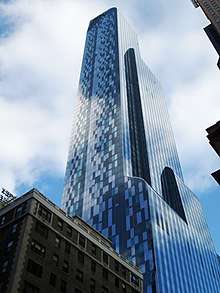Luxury apartment
A luxury apartment is a type of apartment that is intended to provide its occupant with higher-than-average levels of comfort, quality and convenience. While the term is often used to describe high-end regular apartments, or even typical apartments as a form of aspirational marketing, a true luxury apartment is one that is variously defined as being in the top 10% of transactions on the market,[1] or having a total value of more than $4–5 million US dollars, with "ultra-luxury" apartments being valued above US$10 million.[2] However, it can also mean any apartment with extra amenities, such as a doorman, yoga studios or Bowling alleys, among others.[1]

History
The term "luxury apartment" was used since the postwar era, although its definition was less grandiose than in recent times. In the 1980s, for example, having a doorman for the building was sufficient to mark an apartment as "luxury".[1] Competition to make the most luxurious apartment increased due to the growth of the Internet, which allowed potential buyers to cross-check apartment listings.[1]
Current examples
In the United States
As of 2016, three out of every four new apartment buildings in the United States were luxury designs targeted towards high-end buyers.[3] This luxury boom is centered in the fastest-growing American cities, but also includes smaller, less-dense cities.[3] It has been linked to the movement of affluent Americans away from Suburbs to cities, also known as The Great Inversion.[3]
In New York City
The 2010s was marked by the construction of many new luxury condominium towers in New York City, often appealing to wealthy overseas buyers, such as One57 and Central Park Tower.[4] Billionaire's Row became known as the location of many of these towers. Williamsburg, Brooklyn had the highest rent increase, rising by 54% on average from 2010 to 2019. Global economic headwinds and unfavorable changes to property and transfer taxes cooled demand, causing a glut of unsold luxury condos.[4] As of 2019, one in four luxury apartments that were built since 2013 were unsold.[5]
See also
References
- "What does luxury real estate mean when everything is called "luxury"?". Brick Underground. August 2, 2015. Retrieved January 15, 2020.
- "Start popping bottles, your apartment probably qualifies as "luxury"". Brick Underground. February 2, 2015. Retrieved January 15, 2020.
- Groskopf, Christopher. "America's luxury apartment boom is gentrification on steroids". Quartz. Retrieved January 15, 2020.
- Chen, Stefanos (January 1, 2020). "The Decade Dominated by the Ultraluxury Condo". The New York Times. ISSN 0362-4331. Retrieved January 15, 2020.
- Chen, Stefanos (September 1, 2019). "One in Four of New York's New Luxury Apartments Is Unsold". The New York Times. ISSN 0362-4331. Retrieved January 15, 2020.